
|
|

|
|

|
|

|
|

|
|

|
|

|
|

|
|

|
|

|
|

|
|

|
|

|
|

|
|

|
|

|
|

|
|
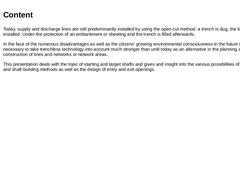
|

Today, supply and discharge lines are still predominantly installed by using the open-cut method: a trench is dug, the lines are installed. Under the protection of an embankment or sheeting and the trench is filled afterwards. In the face of the numerous disadvantages as well as the citizens' growing environmental consciousness in the future it is urgently necessary to take trenchless technology into account much stronger than until today as an alternative … |
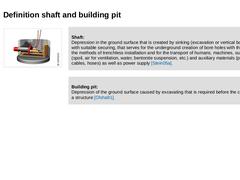
|

|
(Image: Starting and target shafts) |
Shaft:
Depression in the ground surface that is created by sinking (excavation or vertical boring), with suitable securing, that serves for the underground creation of bore holes with the aid of the methods of trenchless installation and for the transport of humans, machines, substances (spoil, air for ventilation, water, bentonite suspension, etc.) and auxiliary materials (pipes, cables, hoses) as well as power … |
|
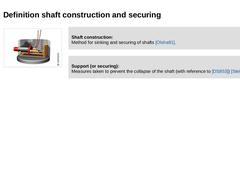
|

|
(Image: Starting and target shafts) |
Shaft construction:
Method for sinking and securing of shafts [Olsha91]. |
|
|
|
Support (or securing):
Measures taken to prevent the collapse of the shaft (with reference to [DS853]) [Stein05a]. |
|
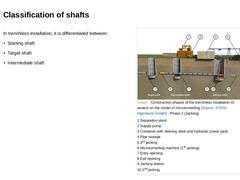
|

In trenchless installation, it is differentiated between: -
Starting shaft
-
Target shaft
-
Intermediate shaft
(Image: Construction phases of the trenchless installation of sewers on the model of microtunnelling - Phase 2 (Jacking)) |
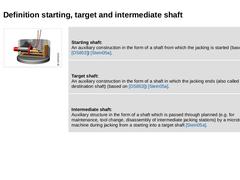
|

|
(Image: Starting and target shafts) |
Starting shaft:
An auxiliary construction in the form of a shaft from which the jacking is started (based on [DS853]) [Stein05a]. |
Target shaft:
An auxiliary construction in the form of a shaft in which the jacking ends (also called destination shaft) (based on [DS853]) [Stein05a]. |
Intermediate shaft:
Auxiliary structure in the form of a shaft which is passed through planned (e.g. for maintenance, tool change, … |
|
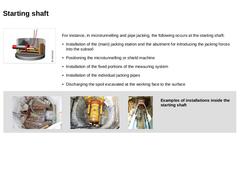
|

(Image: Starting and target shafts) For instance, in microtunnelling and pipe jacking, the following occurs at the starting shaft: -
Installation of the (main) jacking station and the abutment for introducing the jacking forces into the subsoil
-
Positioning the microtunnelling or shield machine
-
Installation of the fixed portions of the measuring system
-
Installation of the individual jacking pipes
-
Discharging the spoil excavated at the working face …
|
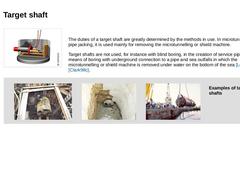
|

|
(Image: Starting and target shafts) |
The duties of a target shaft are greatly determined by the methods in use. In microtunnelling and pipe jacking, it is used mainly for removing the microtunnelling or shield machine. Target shafts are not used, for instance with blind boring, in the creation of service pipes by means of boring with underground connection to a pipe and sea outfalls in which the microtunnelling or shield machine is removed under … |
|
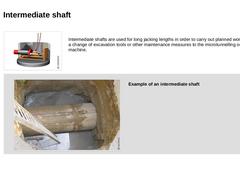
|

|
(Image: Starting and target shafts) |
Intermediate shafts are used for long jacking lengths in order to carry out planned works such as a change of excavation tools or other maintenance measures to the microtunnelling or shield machine. |
|
(Image: View into an intermediate shaft)
Example of an intermediate shaft |
|